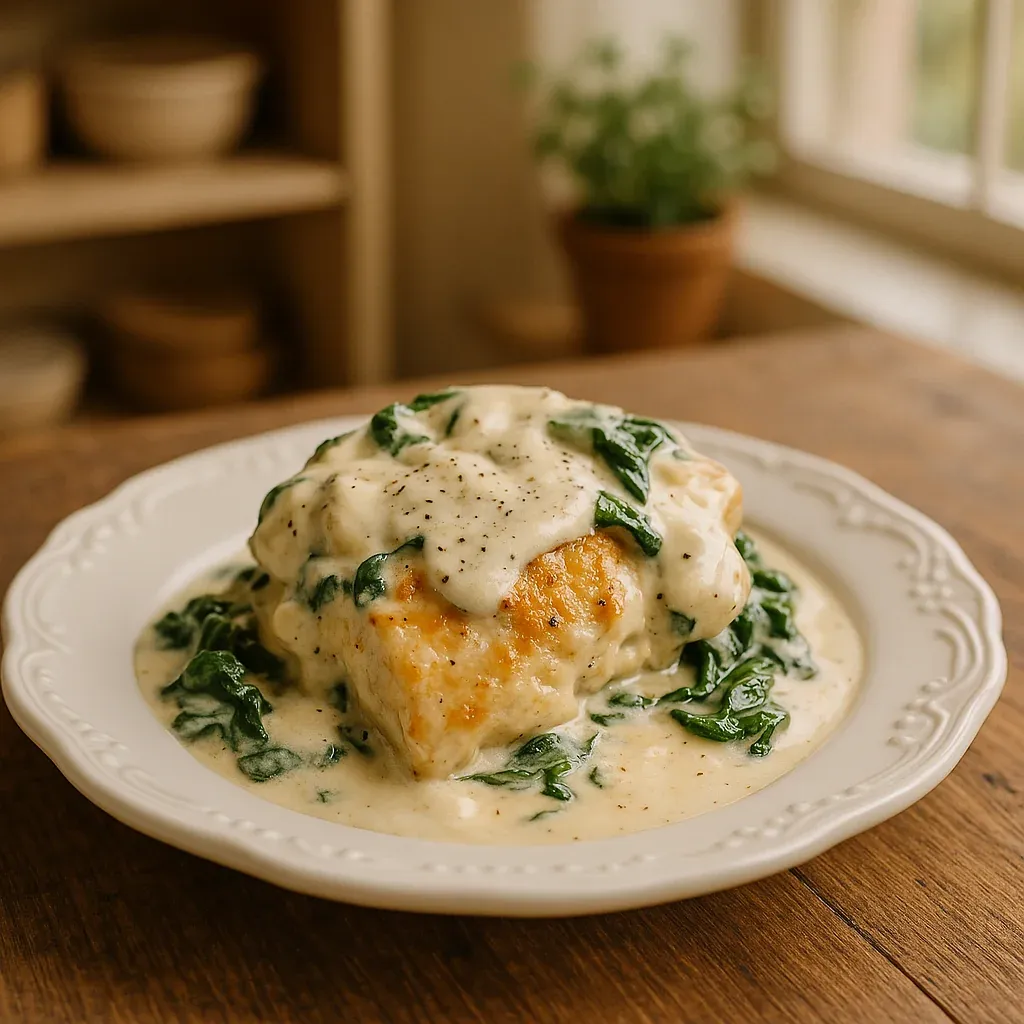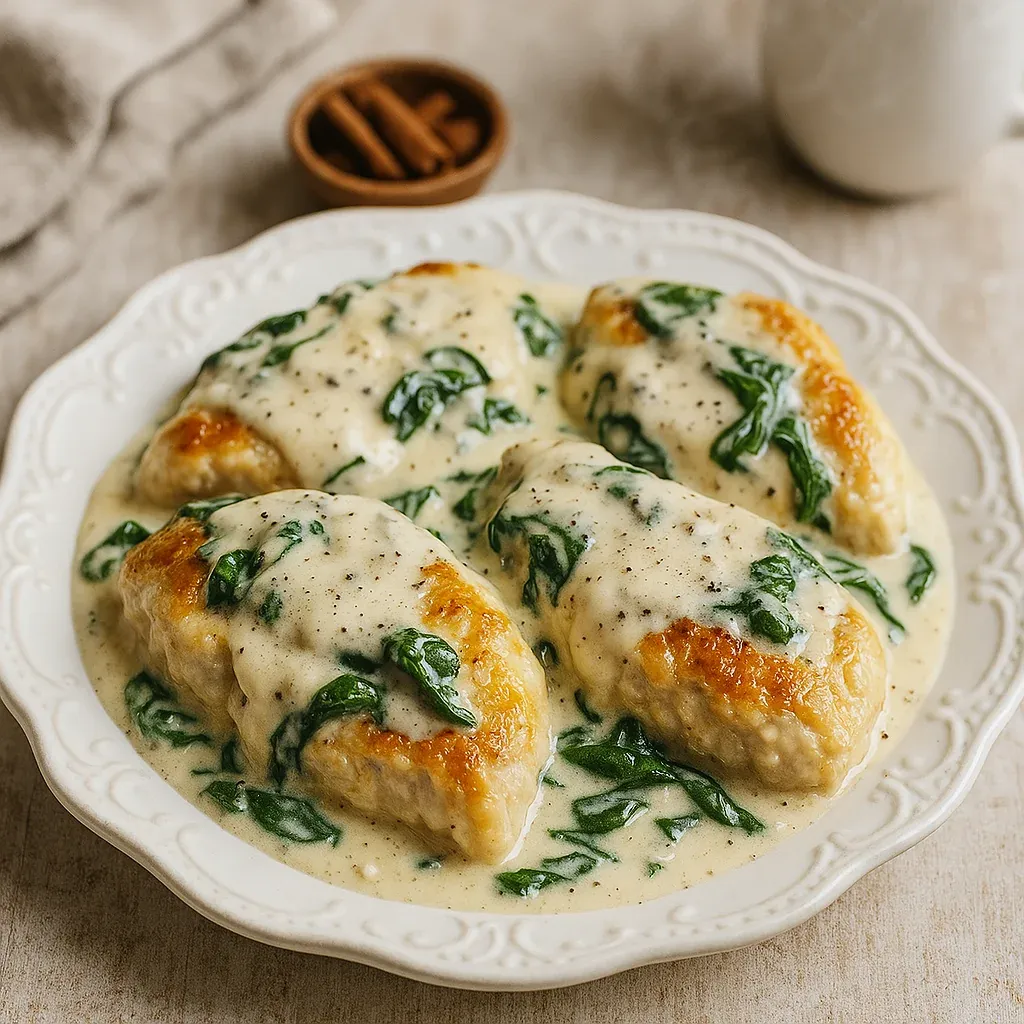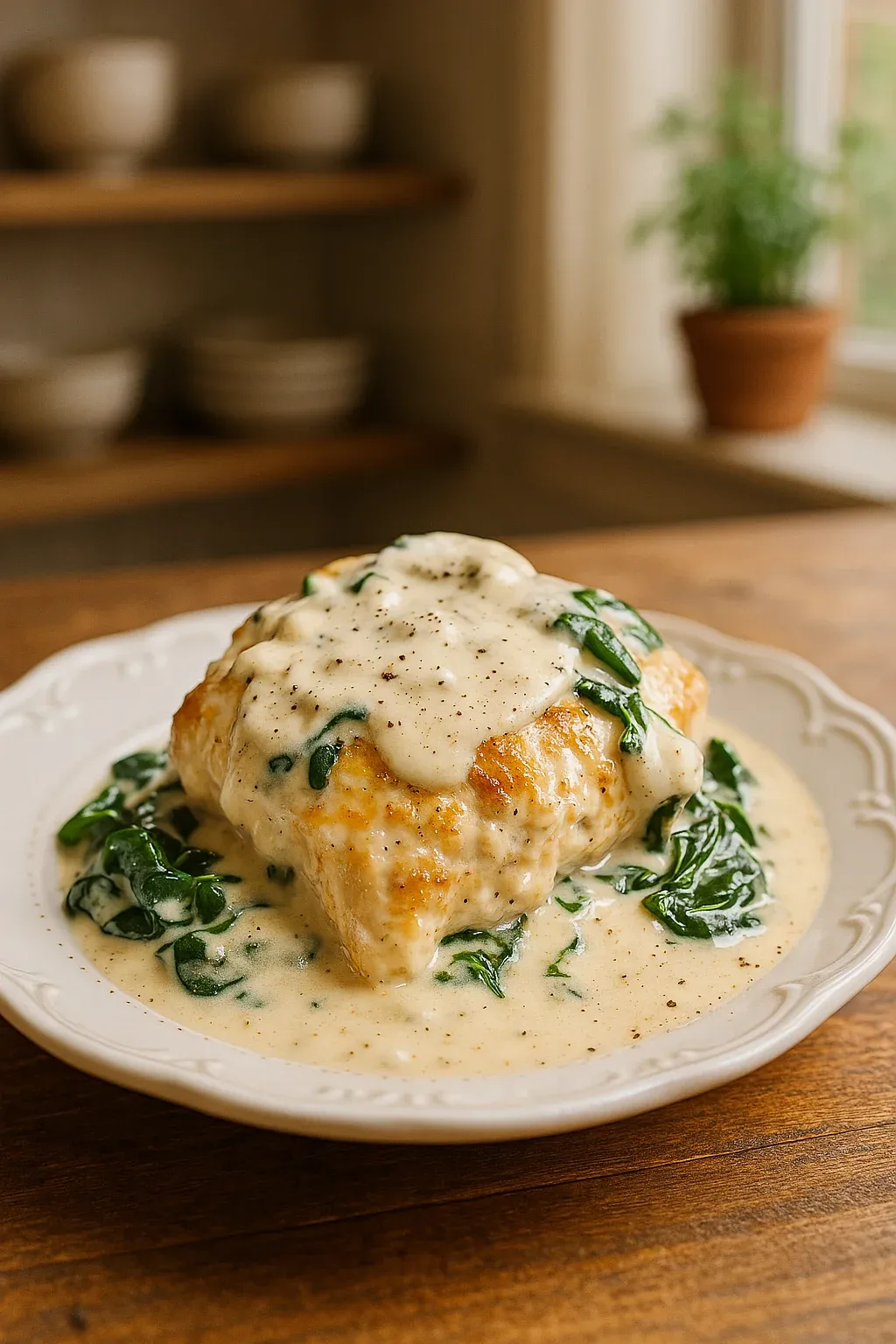 Pin
Pin
This creamy chicken Florentine has been a game-changer in my weeknight dinner rotation. The luxurious sauce combined with tender chicken and fresh spinach creates a restaurant-worthy meal that comes together with surprising ease. Even my pickiest eaters clean their plates when this dish appears on our family table.
I first created this recipe when trying to impress my in-laws during their first visit to our home. The combination of simple ingredients transforming into something so elegant won them over immediately, and now it's requested at nearly every family gathering.
- Boneless skinless chicken breasts: Choose organic, free-range chicken for the best flavor and texture
- Olive oil: Use extra virgin for more robust flavor that enhances the sauce
- Butter: Unsalted gives you better control over the final seasoning
- Garlic, minced: Fresh garlic provides significantly more flavor than pre-minced varieties
- Heavy cream: Creates the luxuriously silky texture that defines this dish
- Chicken broth: Adds depth while keeping the sauce from becoming too heavy
- Parmesan cheese, grated: Freshly grated melts more smoothly than pre-packaged varieties
- Fresh spinach: Baby spinach leaves work best as they wilt perfectly into the sauce
- Italian seasoning: A time-saving blend that provides balanced herbs in one addition
- Salt and pepper: Always season in layers for the most developed flavor
- Red pepper flakes: Optional, but adds a pleasant warmth without overwhelming heat
- Prepare the Chicken:
- Season the chicken breasts generously with salt, pepper, and Italian seasoning on both sides. Take time to evenly coat each piece to ensure consistent flavor throughout. Let the seasoned chicken rest for about 5 minutes which allows the seasonings to adhere better to the meat.
- Sear the Chicken:
- Heat olive oil in a large skillet over medium-high heat until it shimmers but doesn't smoke. Carefully place each chicken breast in the hot oil without overcrowding the pan. Cook for exactly 4 to 5 minutes per side until a beautiful golden crust forms. The chicken should release easily from the pan when it's ready to flip. Once done, transfer to a clean plate and tent loosely with foil to keep warm.
- Make the Sauce:
- Using the same skillet with all those flavorful browned bits, reduce heat to medium and add butter. Once melted, add minced garlic and cook for precisely 30 seconds until fragrant but not browned as burned garlic will ruin the sauce. Pour in chicken broth, scraping the bottom of the pan to incorporate all the flavor particles. Add heavy cream and bring to a gentle simmer, then stir in grated Parmesan cheese until completely melted and smooth, about 2 minutes.
- Add Spinach:
- Add fresh spinach to the simmering sauce in batches, allowing each addition to wilt slightly before adding more. Stir gently to prevent tearing the leaves. The spinach will dramatically reduce in volume as it cooks. Season the sauce with additional salt and pepper to taste.
- Combine Everything:
- Return the seared chicken breasts to the skillet, nestling them into the creamy spinach sauce. Reduce heat to low and allow everything to simmer together for 5 minutes. The chicken will finish cooking through while absorbing the flavors of the sauce. If the sauce becomes too thick, add a small splash of chicken broth to reach your desired consistency.
- Serve and Enjoy:
- Transfer the chicken breasts to plates or a serving platter, spooning generous amounts of the creamy spinach sauce over each piece. Garnish with additional freshly grated Parmesan if desired. Serve immediately while hot alongside your choice of pasta, rice, or crusty bread.

My absolute favorite part of this recipe is the moment when the spinach first hits the hot cream sauce. The vibrant green against the white creates a beautiful visual contrast, and watching the leaves slowly wilt and integrate into the sauce is almost meditative. This dish brings back memories of my grandmother teaching me to cook in her tiny Italian kitchen, always emphasizing that the best meals come from simple ingredients prepared with care.
Storage Tips
The beauty of Chicken Florentine lies in how well it keeps for future meals. Store any leftovers in an airtight container in the refrigerator for up to three days. The flavors actually develop beautifully overnight, making day-two Florentine sometimes even more delicious than the original meal. When reheating, do so gently over low heat in a covered pan, adding a small splash of cream or broth if the sauce has thickened too much during storage. While technically possible to freeze, the creamy sauce can separate upon thawing, so I recommend enjoying this dish fresh or as refrigerated leftovers for the best experience.
Perfect Pairing Suggestions
While pasta is the traditional companion to Chicken Florentine, exploring beyond the expected opens up wonderful possibilities. Creamy polenta creates an additional layer of comfort, while roasted garlic mashed potatoes turn this into a hearty meal perfect for colder months. For a lighter option, steamed asparagus or roasted brussels sprouts provide textural contrast and balance to the rich sauce. If serving for guests, consider starting with a light appetizer like a simple caprese salad and ending with a tart lemon sorbet to cleanse the palate after the creamy main course. A crisp Pinot Grigio or unoaked Chardonnay complements the flavors beautifully without overwhelming them.

The Secret to Perfect Chicken Texture
The difference between good and great Chicken Florentine often comes down to the texture of the chicken itself. For perfectly tender chicken every time, remove your chicken from the refrigerator 15 minutes before cooking to take the chill off. This promotes even cooking from edge to center. Another professional technique is to gently pound the chicken breasts to an even thickness before cooking. This ensures the thinner parts don’t overcook while the thicker sections reach proper doneness. Finally, invest in an instant-read thermometer and cook the chicken just until it reaches 165°F. Any higher and you risk dry, tough results. Remember that the chicken will continue cooking slightly when returned to the hot sauce, so factor this carryover cooking into your timing.
Recipe FAQs
- → How can I make this dish healthier?
For a lighter version, you can use half-and-half instead of heavy cream and serve it over zucchini noodles or cauliflower rice.
- → Can I use chicken thighs instead of chicken breasts?
Yes, boneless, skinless chicken thighs are a great substitute. Simply adjust the cooking time as thighs may take slightly longer to cook through.
- → What can I serve this dish with?
This dish pairs well with pasta, rice, or crusty bread. For a low-carb option, serve with zucchini noodles or cauliflower rice.
- → Can I add other ingredients to the dish?
Absolutely! Sautéed mushrooms, sun-dried tomatoes, or additional vegetables like asparagus would make great additions.
- → How do I store and reheat leftovers?
Store leftovers in an airtight container in the fridge for up to 3 days. Reheat in a skillet over low heat, adding a splash of cream to keep the sauce creamy.
